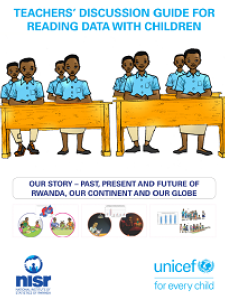
Teachers' discussion guide for reading data with children
Since 2015, around the celebration of the African Statistics Day (ASD), the National Institute of Statistics of Rwanda (NISR) in collaboration with UNICEF Rwanda organizes the “Reading Data with Children”, an event that brings together around 50 children to be trained in reading statistical reports, especially those related directly to their lives, using children friendly readable visualizations with data from Demographic and Health Survey (DHS) and EICV.
This initiative goes with the Data Revolution as defined by Data Revolution Group as the transformative actions needed to respond to the demands of a complex development agenda and private sector needs, improvements in how data is produced and used; closing data gaps to prevent discrimination; building capacity and data literacy in “small data” and big data analytics; modernizing systems of data collection; liberating data to promote transparency and accountability; and developing new targets and indicators.
The main objective of this event is to boost the statistical literacy of the country general population, particularly the young generation, and to make statistics a part of Rwandan children. At the same time, the event aims to nurture the data driven mind among young population who are aspired to architect the country’s future.
Since its launch in November 2015, Reading Data with Children event turned out to be very successful. About 50 children between 12 and 17 participated, boasting equal rates of girls and boys, including some children with disabilities. Children were fascinated by Rwanda’s Millennium Development Goal achievements, and by reading statistics for the first time. They absorbed key messages quickly, such as the importance of education for girls and the correlation between educated mothers and good healthcare practices. By two sessions yet organized, this event illustrated that children (including one with disability) can read and analyze the data if presented and explained with appropriate methodology. This means that children should not be regarded as merely passive audience for the statistics but also active change agents who communicate statistics at home, class room and community.
This teacher’s guide was designed to be interactive, and is intended to be used in a flexible way. As every educator knows, each child and each classroom is unique; therefore, we encourage you to adapt this guide as you see fit.
| File | Download Count |
|---|---|
| 1588 |
